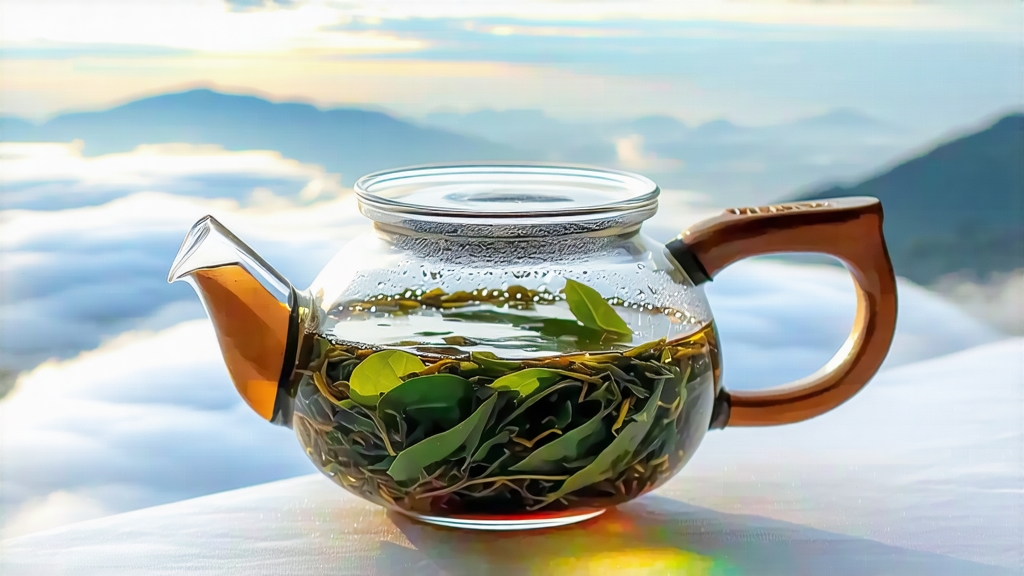
Alishan High-Mountain Oolong is not merely a tea; it is a vertical journey into the mists of central Taiwan. Grown between 1,000 and 1,400 metres on the forested spine of the Alishan Range, this cultivar absorbs 2,600 mm of mist-borne moisture each year, ultraviolet light intensified by altitude, and diurnal temperature swings that can exceed 15 °C within a single spring day. Those climatic stresses slow leaf growth, condensing amino acids and aromatics into a liquor that international tasters often describe as “orchid milk sliding over wet stone.”
Historical roots
Although the Qing-era Fujianese brought Tieguanyin cuttings to Taiwan in the early 1800s, Alishan’s tea story truly begins in 1980, when the Taiwan Tea Research and Extension Station released the TTES #12 “Jin Xuan” hybrid. Farmers in Meishan, Zhuqi and Fanlu townships discovered that Jin Xuan, when planted above the cloud line, abandoned its familiar buttery note and acquired a high-pitched floral register reminiscent of lily and alpine peony. By 1987 Alishan Oolong had become a separate market category, commanding twice the price of low-elevation Jin Xuan and turning seasonal tea fairs in Taipei into perfumed auction theatres.
Cultivar and micro-terroirs
Two clonal bushes dominate today’s Alishan gardens. Jin Xuan (TTES #12) contributes a natural, light milk aroma, while Qing Xin (TTES #13) offers a crisper, more mineral structure. Within Alishan, micro-valleys create subtle signatures: the north-facing Shi Zi Kou plots yield leaves with higher linalool, giving pronounced lavender top notes; south-facing slopes around Feng Qi Hu trap afternoon fog, producing a thicker, almost custard-like body. Farmers often hedge their bets by blending leaf from three altitudinal bands, balancing fragrance, texture and lingering “yun” (rhythmic finish).
Plucking standard
The ideal pluck is “one bud, three leaves” on the 45th day after the spring equinox, when the bud is still hidden like a pearl inside the third leaf. This timing maximises the ratio of hydroxylated carotenoids to chlorophyll, the biochemical prelude to Alishan’s signature peach-skin aroma. Experienced pickers finish each row before 10 a.m., while mountain mist still glistens on the leaf surface, preventing premature enzymatic browning.
Crafting the partial soul
Alishan Oolong is typically 18–25 % oxidised—lighter than Dong Ding yet darker than modern Baozhong. The craft unfolds in six acts:
- Solar withering: leaves are spread on bamboo trays under filtered morning sun for 20 minutes, initiating photolytic breakdown of bitter catechins.
- Indoor withering & tossing: shaken every hour for 8–10 hours in 22 °C mountain air; the bruising triggers a controlled wounding response, releasing jasmine-like indole compounds.
- Fixation: a 3-minute tumble at 160 °C halts oxidation while preserving green chlorophyll rims—a visual hallmark of high-mountain processing.
- Rolling: the semi-hot leaves are wrapped in cotton cloth and compressed into balls, rupturing cell walls without breaking veins; this repeated sphere-forming (up to 60 cycles) creates the tight dragon-eye pellet that will unfurl like origami in your teapot.
- Initial drying: 80 °C for 40 minutes reduces moisture to 12 %, locking in the milky-lactone bouquet.
- Roasting continuum: light “zou wei” (flavour walking) roast at 90 °C for 4–6 hours removes grassy edges; deeper charcoal roasts are rare, reserved for winter harvests destined for ageing.
Water & fire: brewing rituals
Alishan Oolong is forgiving, yet altitude in the cup mirrors altitude on the mountain: precision lifts it skyward.
Gongfu style (recommended)
- Vessel: 100 ml white porcelain gaiwan or zhuni clay teapot.
- Leaf: 6 g (roughly two heaping tablespoons).
- Rinse: 95 °C water, 5-second flash to awaken the pellet.
- Infusions: 1st—45 s; 2nd—35 s; 3rd—45 s; 4th—55 s; extend 10–